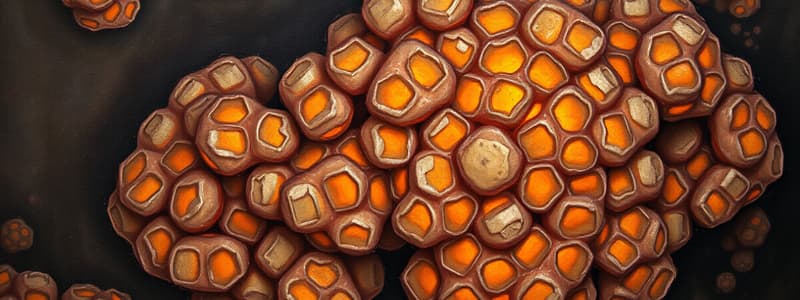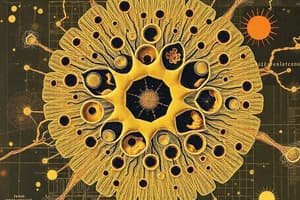Podcast
Questions and Answers
What is the primary function of the nucleolus within the nucleus?
What is the primary function of the nucleolus within the nucleus?
- Storage of neurofilaments
- Duplication of chromosomes
- Gene expression
- Ribosomal RNA synthesis and ribosome subunit assembly (correct)
What characteristic is unique to the Barr Body in females?
What characteristic is unique to the Barr Body in females?
- It is a prominent nucleolus.
- It is a compacted X-chromosome. (correct)
- It represents duplicated chromosomes.
- It forms the microtubules.
Which component has a diameter of approximately 3 to 5 nm and is formed by actin?
Which component has a diameter of approximately 3 to 5 nm and is formed by actin?
- Microfilaments (correct)
- Microtubules
- Neurofilaments
- Chromosomes
How do neurofilaments contribute to the structure of cells?
How do neurofilaments contribute to the structure of cells?
What diameter do microtubules have?
What diameter do microtubules have?
What role do microtubules play in cellular function?
What role do microtubules play in cellular function?
What is the relationship between the nuclear envelope and the rough endoplasmic reticulum?
What is the relationship between the nuclear envelope and the rough endoplasmic reticulum?
What is the approximate diameter of neurofilaments?
What is the approximate diameter of neurofilaments?
What is the primary characteristic of the refractory period in nerve impulses?
What is the primary characteristic of the refractory period in nerve impulses?
What distinguishes rapid cell transport from slow cell transport?
What distinguishes rapid cell transport from slow cell transport?
Which of the following components is NOT typically associated with rapid cell transport?
Which of the following components is NOT typically associated with rapid cell transport?
Which statement correctly defines synapses in the context of neurons?
Which statement correctly defines synapses in the context of neurons?
Which of the following best describes the transmission speed of slow cell transport?
Which of the following best describes the transmission speed of slow cell transport?
What type of molecules form the main structure of the plasma membrane?
What type of molecules form the main structure of the plasma membrane?
What initiates the sudden change in the membrane's polarity during an action potential?
What initiates the sudden change in the membrane's polarity during an action potential?
What is the thickness of the plasma membrane?
What is the thickness of the plasma membrane?
What occurs immediately after the action potential reaches +40 mV?
What occurs immediately after the action potential reaches +40 mV?
Which layer of the plasma membrane directly interacts with the exterior environment?
Which layer of the plasma membrane directly interacts with the exterior environment?
What structural feature of phospholipids contributes to the selective permeability of the plasma membrane?
What structural feature of phospholipids contributes to the selective permeability of the plasma membrane?
What type of molecules are linked to the proteins and lipids forming the glycocalyx?
What type of molecules are linked to the proteins and lipids forming the glycocalyx?
How is the nerve impulse described in terms of its propagation?
How is the nerve impulse described in terms of its propagation?
What defines an axodendritic synapse?
What defines an axodendritic synapse?
Which type of astrocytes are characterized by their long, slender processes?
Which type of astrocytes are characterized by their long, slender processes?
Which of the following correctly describes protoplasmic astrocytes?
Which of the following correctly describes protoplasmic astrocytes?
What is a key characteristic of axosomatic synapses?
What is a key characteristic of axosomatic synapses?
Which statement is true regarding neuroglia?
Which statement is true regarding neuroglia?
What pathological feature differentiates fibrous astrocytes in astrocytomas?
What pathological feature differentiates fibrous astrocytes in astrocytomas?
What best describes the general role of astrocytes?
What best describes the general role of astrocytes?
Which of the following statements is false about axoaxonic synapses?
Which of the following statements is false about axoaxonic synapses?
What is the primary role of the Golgi complex in a nerve cell?
What is the primary role of the Golgi complex in a nerve cell?
Which characteristic is NOT associated with mitochondria?
Which characteristic is NOT associated with mitochondria?
Where is the Golgi complex located in relation to the nucleus?
Where is the Golgi complex located in relation to the nucleus?
What is the diameter range of mitochondria?
What is the diameter range of mitochondria?
What is a prominent function of enzymes found in mitochondria?
What is a prominent function of enzymes found in mitochondria?
Which of the following correctly describes neurofibrils?
Which of the following correctly describes neurofibrils?
What substance is transferred to the cis side of the Golgi complex?
What substance is transferred to the cis side of the Golgi complex?
Which areas of the cell are mitochondria predominantly located?
Which areas of the cell are mitochondria predominantly located?
Flashcards are hidden until you start studying
Study Notes
Golgi Complex
- A network with irregular thread-like structures surrounding the nucleus.
- Composed of smooth-surfaced endoplasmic reticulum (ER).
- Nissl substance (containing proteins) is transported to the cis side of the Golgi complex.
Mitochondria
- Can be spherical or rod-shaped, distributed throughout cell bodies, axons, and dendrites.
- House many enzymes involved in the tricarboxylic acid cycle and respiratory cytochrome chains.
- Essential for energy production, with diameters ranging from 5 µm to 135 µm.
Nucleus
- Central, large, and rounded structure storing genetic material.
- Chromosomes do not duplicate but are involved in gene expression.
- Contains a prominent nucleolus responsible for synthesizing ribosomal RNA (rRNA).
- In females, one X chromosome forms a Barr Body, located on the inner surface of the nuclear envelope.
Nuclear Envelope
- A specialized portion of rough endoplasmic reticulum (RER) with a double-layered structure.
- Features fine nuclear pores that allow movement of materials in and out of the nucleus.
Cytoplasm
- Rich in granular and agranular endoplasmic reticulum.
- Serves as a continuous external boundary of the cell body and its processes.
- Initiates and conducts nerve impulses.
Plasma Membrane
- Approximately 8 nm thick, consisting of inner and outer layers of loosely arranged proteins separated by a lipid layer.
- Lipid layer contains two rows of phospholipid molecules, contributing to membrane structure and function.
- Involves CHO molecules which form the Glycocalyx, aiding in cell recognition and interaction.
Action Potential
- Peaks at +40 mV and lasts for about 5 milliseconds.
- Results from a sudden influx of Na+ ions, followed by a rush of K+ ions that helps restore the resting state.
- Self-propagating effect as the action potential spreads across the plasma membrane.
- Following an action potential, there's a refractory period where another cannot be generated immediately.
Cell Transport
- Involves movement of organelles, secretory materials, and other components within the cell.
- Rapid cell transport rates range from 100 to 400 mm per day, while slow transport rates are between 0.1 to 3 mm per day.
Synapses
- Points of close proximity between two neurons where communication occurs.
- Axodendritic synapses are the most common, occurring between axons of one neuron and dendrites of another.
- Axosomatic synapses involve connections between an axon and the soma of another neuron.
- Axoaxonic synapses connect the terminals of different neurons.
Neuroglia
- Non-excitable cells supporting neurons in the central nervous system (CNS).
- Outnumber neurons 5-10 times and comprise 50% of the brain and spinal cord volume.
- Lack axons and do not form synapses.
Types of Astrocytes
- Fibrous Astrocytes: Located in white matter; characterized by long, slender, and smooth processes, less branched. Linked to astrocytoma tumors due to glial fibrillary acid protein (GFAP).
- Protoplasmic Astrocytes: Found in gray matter, with shorter, thicker, and more branched processes that intersperse with nerve cell bodies.
Functions of Astrocytes
- Critical for maintaining the environment around neurons, providing structural support, and assisting in the regulation of ion and neurotransmitter concentrations.
Studying That Suits You
Use AI to generate personalized quizzes and flashcards to suit your learning preferences.



